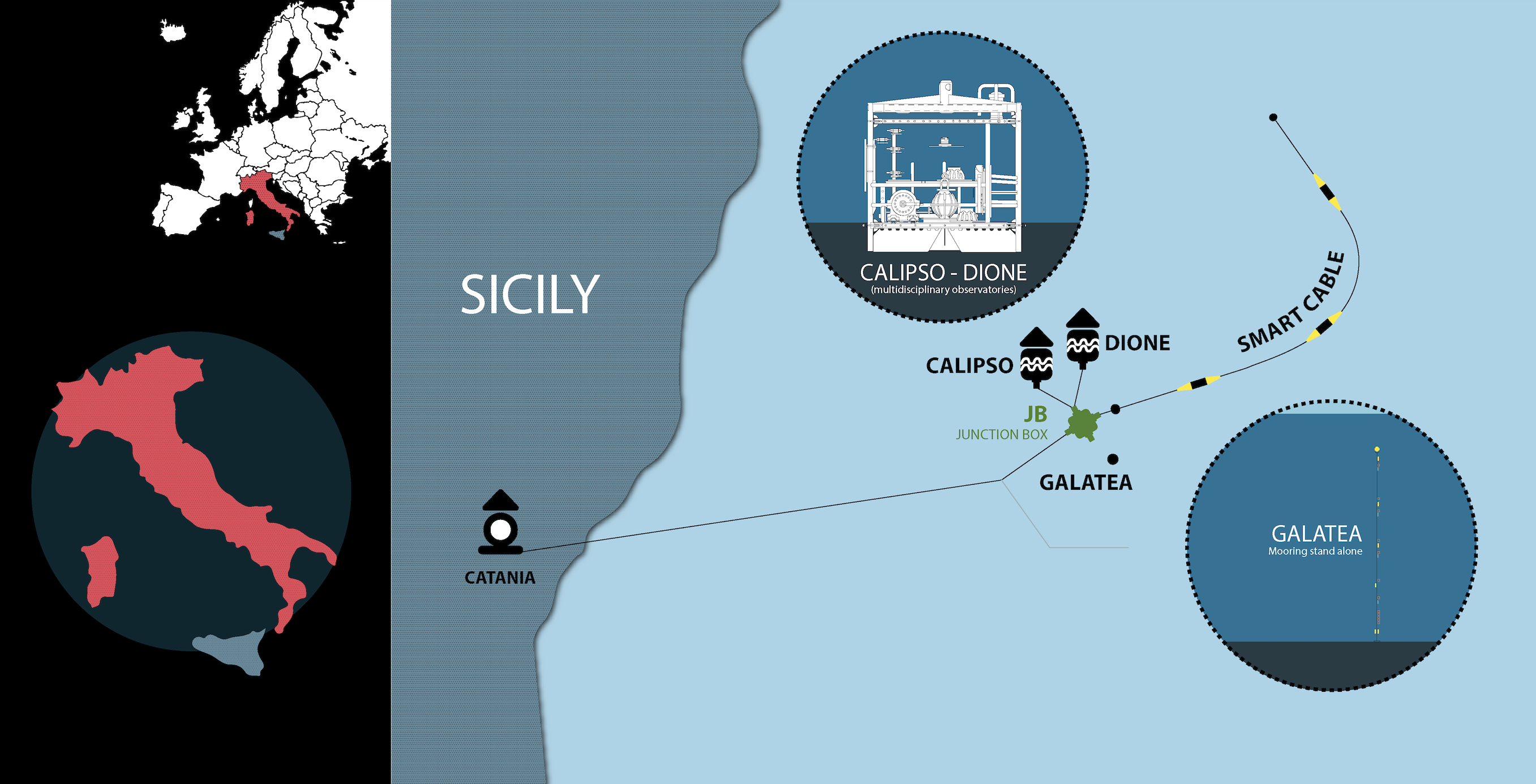After an intense and successful deployment campaign, held at the end of 2023, the EMSO Western Ionian Sea facility (WIS) has recently enriched its configuration in the framework of the Italian project InSEA – Initiatives in Supporting the consolidation and enhancement of the EMSO – European Research Infrastructure Consortium (ERIC) – and related Activities, funded by the Italian Ministry of University and Research in the period 2019-2023.
Three new seafloor monitoring components, an innovative device, the SMART CABLE and CALIPSO and, DIONE, definitely changed the original configuration of the facility. In addition, after a regular refurbishment, in March 2024, the mooring line GALATEA, was deployed in autonomous configuration nearby the above mentioned seafloor components
THE CAMPAIGN
Antonio Meucci Cable-layer Vessel, managed by the Italian Company ELETTRA TLC, supported the technical and scientific team running the renovation operations of the WIS seafloor infrastructure. A team of INGV researchers and engineers from SEA Engineering and GURALP System, managed the replacement of the cable termination frame by which the monitoring platforms are powered and connected to the underwater electro-optical cable, and installed a new and high-performance Junction Box capable of simultaneously distributing the power to CALIPSO, DIONE and the SMART cable.
The connection of the platforms to the Junction Box was performed by means of a TOMAHAWK ROV managed by the Italian Company Aalea Offshore.
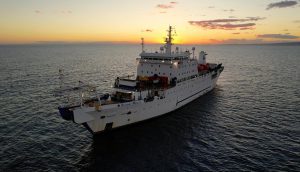
The Antonio Meucci cable layer vessel.
SMART CABLE
The InSEA wet demo SMART (Science Monitoring And Reliable Telecommunications) cable developed as an activity of the InSea project, is among the very few demonstrators worldwide of innovative sensor equipment. A standard submarine telecommunication cable hosts scientific sensors for seismic, ocean and climate monitoring inside repeaters connecting pairs of cables segments,
This innovative approach is supported by a Joint Task Force (JTF) between the International Telecommunication Union, the World Meteorological Organization,and the UNESCO Intergovernmental Oceanographic Commission. At WIS, the SMART cable is 21-kms-long and hosts three repeaters, each 6 km away from the others. Each repeater incorporates a seismometer, an accelerometer and sensors of water pressure and temperature.
The instrumented repeaters were jointed to the telecommunication cable on board of the Vessel and layed similarly to a telecommunication cable, at the laying speed of a common telecommunications cable, without any particular attention to the positioning of the sensors, as instead happens in the case of platforms like CALIPSO and DIONE which were laid with the assistance of the ROV.
The SMART cable data, feeding in real-time a dedicated database currently accessible to the INGV team only, is being transferred in real time to the seismic and tsunami surveillance centers of INGV in Rome. The sketch of the deployed wet-demo SMART cable is given below.
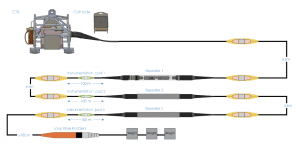
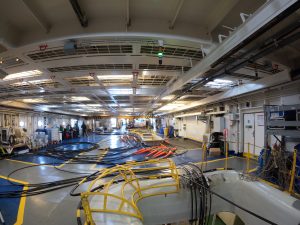
Antonio Meucci Cable-layer VesseI’s workshop interior during the SMART Cable deployment installation phase

The SMART cable on theAntonio Meucci’s deck during the deployment phase.
CALIPSO and DIONE
WIS now operates twin cabled seabed platforms, located at about 2000 m water depth, 20 Km offshore off-shore the harbor of Catania. The platforms are made of marine aluminum frames and host various instruments for geophysical and oceanographic measurements All the data is acquired according to a single time synchronization system based on GPS signal, and delivered on shore in real time. CALIPSO and DIONE are parts of a new class of seabed platforms, they are an improved evolution of the previous platforms (such as SN1). Several geophysical, physical-oceanographic, chemical, and environmental monitoring sensors are installed on these seabed platforms:
- an integrated seismometer (velocity meter plus accelerometer) measures seabed movements;
- a gravimeter, measures variations in the gravitational field;
- a CTD (Conductivity,Temperature, Depth) monitors the variability of hydrological variables in deep layers, with several additional sensors such as oxygen sensor, chlorophyll fluorometer and turbidimeter;
- an ADCP(Acoustic Doppler Current Profiler) measures water masses speed in the layers above the platform;
- high-frequency hydrophones (up to 200 kHz) and a low-frequency hydrophone (up to 12 kHz) detect geophysical and oceanographic signals, track the cetaceans and detect anthropic activity sounds;
- a pressure sensor measures the variation in the water column height useful for the possible tsunamis signal detection.
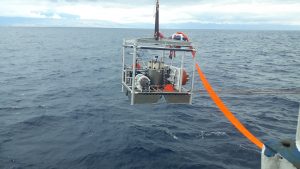
Deployment of DIONE
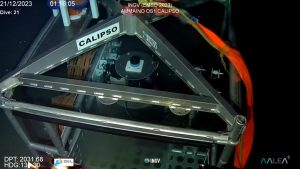
Touchdown of CALIPSO at 2000 m of depth
GALATEA
Since 2021, WIS has been enhanced with the mooring line GALATEA that integrates deep information collected by CALIPSO e DIONE platforms with the variables describing the water column processes.
GALATEA mooring line, developed in collaboration with CNR-ISMAR, is approximately 2000m long and is equipped to monitor temperature, salinity, dissolved oxygen, turbidity, and current velocity at four depth levels (approximately 400, 900, 1400, and 1900 meters). The collected data is currently recorded locally and are retrieved twice a year during the refurbishment operations.

Galatea – mooring line assembly work
Author: Alessandra Giuntivi (INGV)


